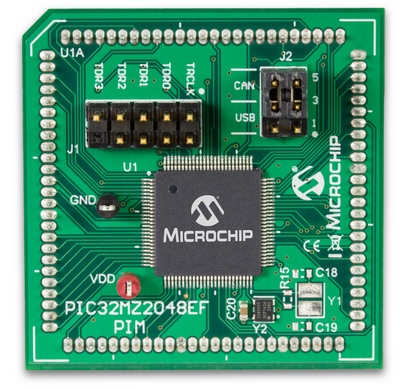Microchip PIC32MZ EF PIM (MA320019)
| Manufacturer | Microchip |
| Part Number | MA320019 |
The PIC32MZ Embedded Connectivity with Floating Point Unit (EF) PIM is designed to demonstrate the capabilities of the PIC32MZ Embedded Connectivity with Floating Point Unit (EF) family of devices using development boards, such as the Explorer 16 Development Board, which supports 100-pin PIM interfaces.
Detailed Description
The PIC32MZ EF series is powered by Imagination’s MIPS M-Class core at 200MHz/330 DMIPS and 3.28 CoreMarks/MHz, along with dual-panel, live-update Flash (up to 2 MB), large RAM (512 KB) and the widest selection of connectivity peripherals in the entire PIC32 portfolio, including a 10/100 Ethernet MAC, Hi-Speed USB MAC/PHY and dual CAN ports.
Many embedded applications are adding better graphics displays, and the PIC32MZ EF, in the LCCG configuration, can support up to a WQVGA display without the added cost of external graphics controllers. An optional, full-featured hardware crypto engine is also available with a random number generator for high-throughput data encryption/decryption and authentication (e.g., AES, 3DES, SHA, MD5 and HMAC).

Key Features:
- 200 MHz/330 DMIPS, MIPS Warrior M-class core
- DSP-enhanced core:
- Four 64-bit accumulators
- Single-cycle MAC, saturating and fractional math
- IEEE 754-compliant
- Dual Panel Flash for live update support
- FPU for fast single- and double-precision math
- 12-bit, 18 MSPS, 40-channel ADC module
- Memory Management Unit for optimum embedded OS execution
- microMIPS mode for up to 35% code compression
- CAN, UART, I2C, PMP, EBI, SQI & Analog Comparators
- SPI/I2S interfaces for audio processing and playback
- Hi-Speed USB 2.0 Device/Host/OTG
- 10/100 Mbps Ethernet MAC with MII and RMII interface
- Temperature Range: - 40°C to 85°C; - 40°C to 125°C (planned)
- Microcontroller Features
- Operating voltage range of 2.2V to 3.6V
- 2MB Flash memory (plus an additional 160 KB of Boot Flash)
- 512KB SRAM memory
- microMIPS mode for up to 35% smaller code size
- DSP-enhanced core:
- Four 64-bit accumulators
- Single-cylce MAC, saturating and fractional math
- IEEE 754-compliant
- FPU for fast single- and double-precision math
- Code-efficient (C and Assembly) architecture
- Low-power management modes (Idle and Sleep)
- Peripheral Features
- 50 MHz External Bus Interface (EBI)
- 50 MHz Serial Quad Interface (SQI)
- Peripheral Pin Select (PPS) functionality to enable function remap
- 8 channels of hardware programmable DMA and 18 channels of dedicated DMA with automatic data size detection
- Six UART modules (25 Mbps): Supports LIN 1.2 and IrDA protocols
- Two CAN modules 2.0B Active with DeviceNet addressing support
- Six 4-wire SPI modules (50 Mbps)
- SQI configurable as an additional SPI module (50 MHz)
- Five I2C modules (up to 1 Mbaud) with SMBus support
- Parallel Master Port (PMP)
- Hardware Real-Time Clock and Calendar (RTCC)
- Nine 16-bit Timers/Counters (four 16-bit pairs combine to create four 32-bit timers)
- Nine Capture inputs and Nine Compare/PWM outputs
- Audio/Graphics/Touch HMI Features
- Graphics interface: EBI or PMP
- Audio data communication: I2S, LJ, RJ, USB
- Audio data control interface: SPI and I2C™
- Audio data master clock: Fractional clock frequencies with USB synchronization
- Advanced Analog Features
- 12-bit ADC Module:
- 18 Msps rate with six Sample and Hold (S&H) circuits (five dedicated and one shared)
- Up to 40 analog inputs
- Can operate during sleep and idle modes
- Multiple trigger sources
- Six digital comparators and six digital filters
- Two analog comparators with 32 programmable voltage references
- Temperature sensor with ±2°C accuracy
- Debugger Development Support
- In-circuit and in-application programming
- 4-wire MIPS® Enhanced JTAG interface
- Unlimited program and 12 complex data breakpoints
- IEEE 1149.2-compatible (JTAG) boundary scan
- Non-intrusive hardware-based instruction trace